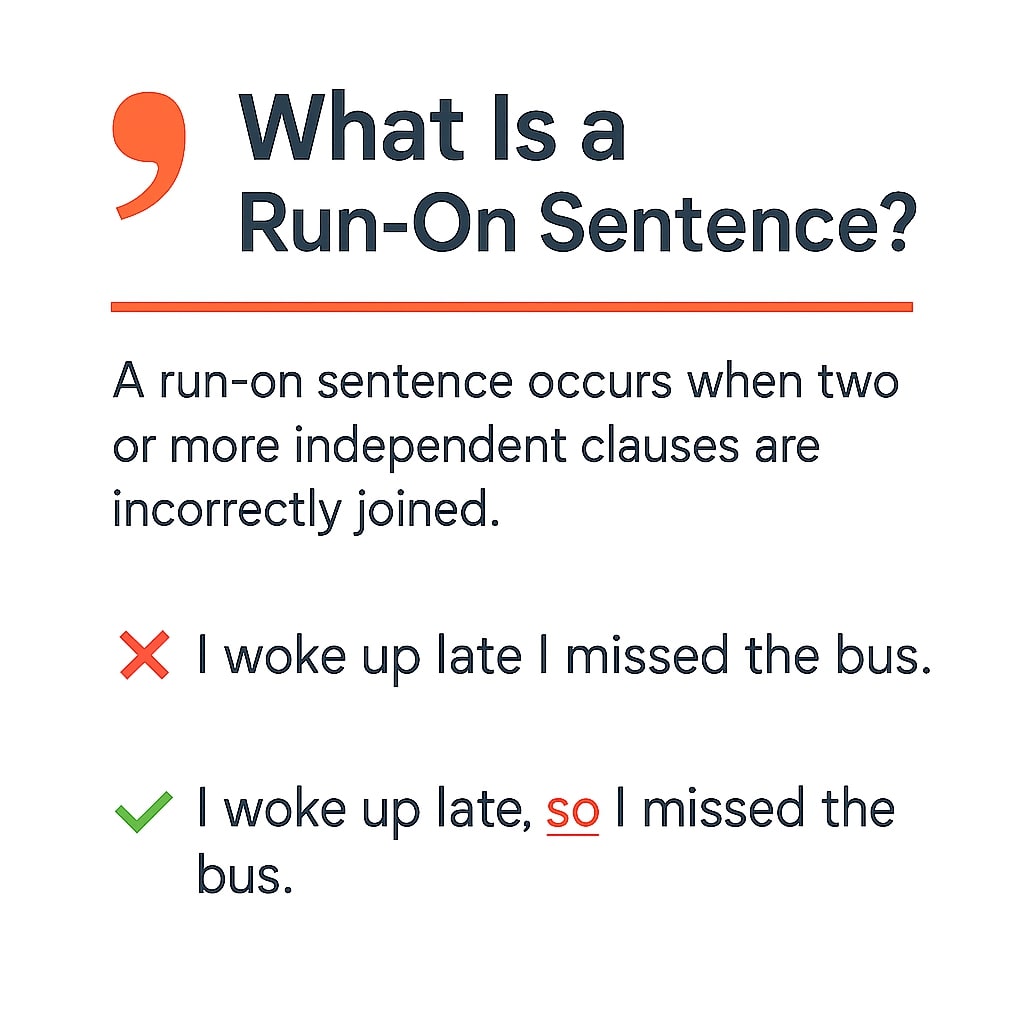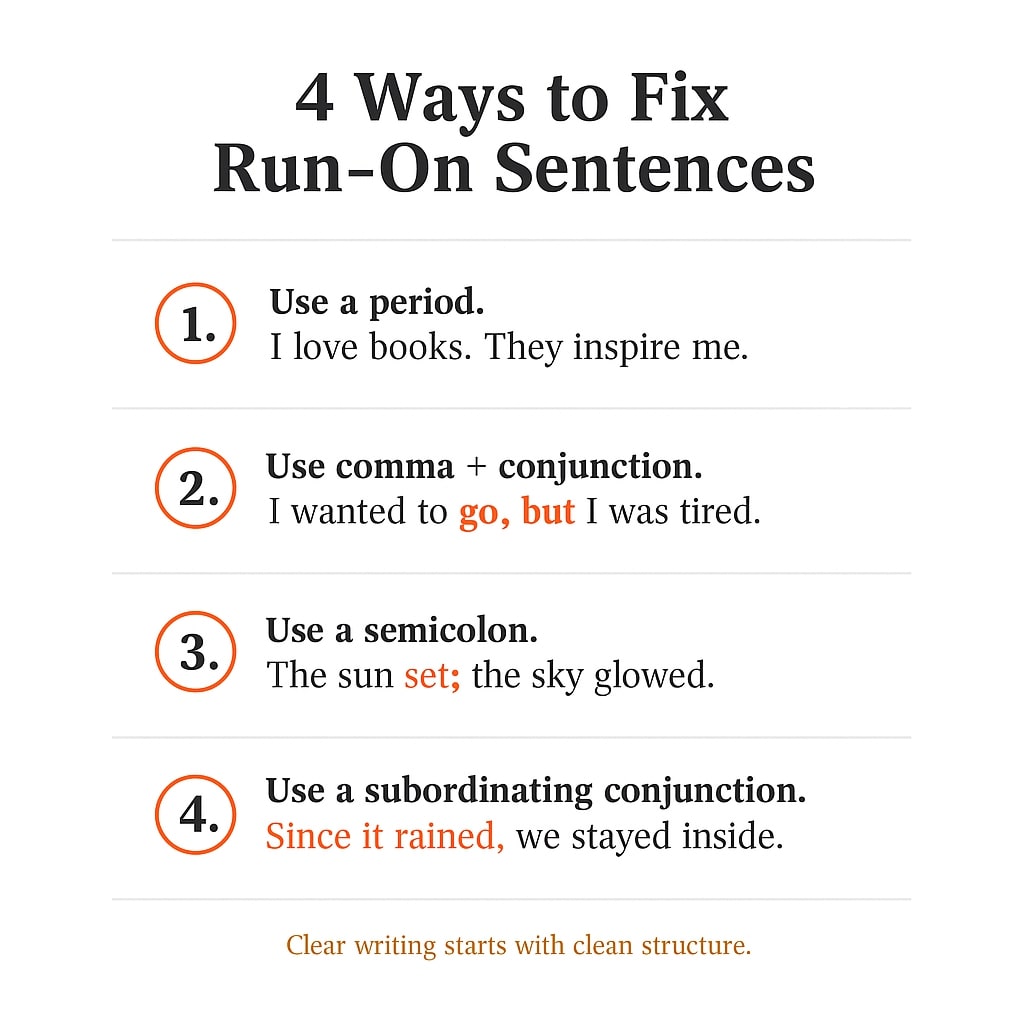How to Fix Run-On Sentences: The Complete Beginner’s Guide (With Examples)
Run-on sentences make your writing confusing and hard to follow. This beginner-friendly guide shows you exactly how to spot and fix them—fast, with real examples.
Ever read a sentence that just keeps going... and going... until you forget what it was even about?
Here’s one:
I love to write sentences they keep going and going without stopping and sometimes they don’t make sense but I just keep writing.
Exhausting, right? That’s a run-on sentence in action — where two or more complete thoughts are crammed into one sentence without proper punctuation or connectors.
Not only do run-on sentences make your writing feel messy and rushed, but they confuse your readers and dilute your message.
The good news?
You can fix run-on sentences easily—once you understand what a run-on sentence actually is, how to spot one, and the best ways to fix them using punctuation, conjunctions, or sentence breaks.
In this guide, you’ll learn:
✅ What a run-on sentence is (and why most people misunderstand it)
✅ Run-on sentence examples that show exactly what to avoid
✅ The two types of run-on sentences: comma splices vs fused sentences
✅ How to fix grammar mistakes that hurt clarity and readability
By the end, you’ll know exactly how to avoid run-on sentences—and write clean, clear sentences that actually stick with your readers.
Let’s get started.
What run-on-sentences are?
A run-on sentence is two or more independent clauses incorrectly presented in a single sentence. In simple words a run-on sentence happens when two or more independent clauses are joined incorrectly. This makes the sentence confusing and difficult to read. For example:
- I woke up late I missed the bus.
Here, two complete thoughts are crammed into one sentence without proper punctuation or a linking word, which makes it unclear.
To understand why run-on sentences are a problem, you first have to understand independent and dependent clauses and the difference between them.
An independent clause is a complete sentence that can stand alone. It has a subject and a verb and makes sense by itself. For example:
- She enjoys painting.
- The weather was nice yesterday.
A dependent clause, on the other hand, cannot stand alone. It needs an independent clause to complete its meaning. For example:
- Because she enjoys painting… (This doesn’t form a complete thought on its own.)
- Although the weather was nice yesterday… (This leaves the reader waiting for more information.)
Now, when two independent clauses are joined incorrectly, a run-on sentence is formed.
Related: Why Plagiarism Is Wrong: 9 Brutal Truths You Can’t Ignore
Types of run-on sentences
A run-on sentence is not defined by its length! The fact that a sentence is very long does not automatically make it a run-on sentence. Run-on sentences are divided into two types that make them grammatically incorrect.
- Fused sentence – When two independent clauses are placed together without any punctuation or a connecting word.
- He loves to cook he tries new recipes every weekend.
- Correction: He loves to cook, so he tries new recipes every weekend.
- Comma splice – When two independent clauses are joined only with a comma, but without a proper linking word.
- She finished her work early, she went for a walk.
- Correction: She finished her work early, so she went for a walk. OR She finished her work early. She went for a walk.
Run-on sentences make sentences confusing and hard to follow. It is one of the main reasons why grammar is important.
Fixing them is simple—use punctuation, add conjunctions, or break them into separate sentences. This helps sentences flow naturally and makes the message easier to understand.
You can also use a grammar error checker to spot run-on sentences, missing punctuation, and other mistakes to refine your writing.
Some common examples of run-on sentences
Wrong: I love to write. It is my favorite hobby.
In this sentence two independent clauses are joined with no punctuation.
Correct: I love to write. It is my favorite hobby. (Separate with a period)
Wrong: She ran to the store she forgot to buy milk.
Two complete thoughts are incorrectly combined without punctuation.
Correct: She ran to the store, but she forgot to buy milk. (Use a comma + conjunction)
Wrong: The movie was great I want to watch it again.
No punctuation separates the two complete ideas.
Correct: The movie was great; I want to watch it again.
Wrong: I was tired I went to bed early.
Two independent clauses run together without a connector.
Correct: I was tired, so I went to bed early.
Wrong: We went to the park we had a picnic.
There is no punctuation or linking word between two ideas.
Correct: We went to the park, and we had a picnic.
Wrong: She plays the piano he plays the guitar.
Two separate thoughts are crammed into one sentence.
Correct: She plays the piano, and he plays the guitar.
Wrong: It was raining hard we stayed inside.
Two independent clauses are written without punctuation.
Correct: It was raining hard, so we stayed inside.
By following an incremental approach of sentence writing, you can eliminate the chances of creating run-on sentences and improve sentence structure effortlessly.
4 ways to fix a run-on sentence
Here are four simple ways to connect independent clauses and fix run on sentences:
1. Use a period
One of the easiest ways to fix a run-on sentence is by separating the two independent clauses into separate sentences. A period signals a clear stop, it makes the writing more readable and prevents confusion. If each part of the sentence can stand alone as a complete thought, using a period is a simple and effective fix.
Incorrect: I love reading books they take me to different worlds.
Correct: I love reading books. They take me to different worlds.
Here, the first part expresses a complete thought about loving books, while the second part explains why. Without a period, the sentence runs together and feels rushed. Separating them makes the meaning clearer.
2. Use a comma with a coordinating conjunction
Coordinating conjunctions—such as and, but, or, so, yet, nor, and for—help connect two independent clauses (complete thoughts) in a way that makes the sentence flow naturally. However, a comma must be placed before the conjunction to avoid creating a run-on sentence.
Without a comma, the sentence may feel confusing because two independent ideas are crammed together without a clear separation.
Incorrect: I wanted to go to the concert but I had too much work.
Correct: I wanted to go to the concert, but I had too much work.
The comma clarifies that "I wanted to go to the concert" and "I had too much work" are separate, complete thoughts.
3. Use a semicolon
A semicolon works well when the two parts of the sentence are closely related and flow naturally together. It acts as a stronger pause than a comma but still connects the ideas without needing a conjunction. This method is useful when both thoughts are equally important and you don’t want to separate them into two sentences.
Correct: The deadline is approaching; we need to finish the report today.
Why? Both clauses are complete sentences on their own, but they are closely connected because one explains the urgency of the other.
4. Use a subordinating conjunction
Using transition words or subordinating conjunctions like because, although, since, help show the relationship between the two ideas by making one part dependent on the other.
This method is useful when one idea is more important than the other and needs additional context to be fully understood. It also helps make the sentence more natural and varied instead of relying only on short, simple statements.
Incorrect: I love coffee I can’t start my day without it.
Correct: Since I love coffee, I can’t start my day without it.
Here, since helps link the two ideas by showing the reason why the person can’t start their day without coffee.
Final words
Run-on sentences make writing confusing and difficult to follow, but they are easy to fix. By using proper punctuation, conjunctions, or breaking sentences apart, you can create clearer and more structured writing.
If you’re still struggling to restructure them, rewriteway’s AI rewriter and Grammarly's AI rewriter can help rewrite your sentences for better clarity.
Whether you use a period, a comma with a conjunction, a semicolon, or a subordinating conjunction, each method helps improve readability. Keeping your sentences well-structured ensures your message is clear, making it easier for readers to understand and follow your ideas.
Rewriteway.com is becoming the go-to tool for rewriting text. It beats bigger names in terms of features, performance, and efficiency.
To learn more, read Rewriteway vs Ahrefs & Rewriteway vs Quillbot guides.


